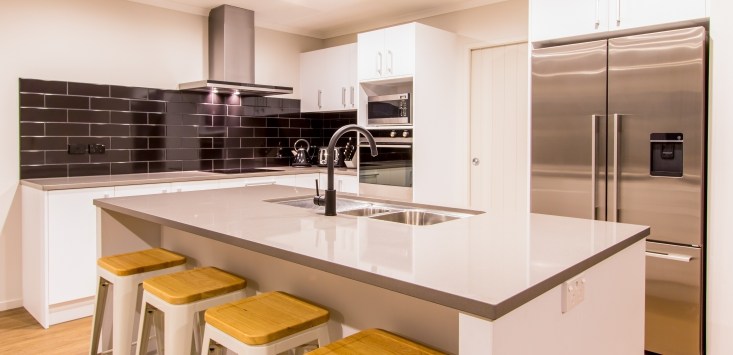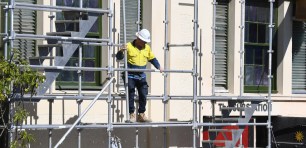
A modern kitchen benchtop. Source: Adobe Stock
Australia’s union movement says its members will forbid the use and transportation of engineered stone unless state and federal governments formally ban it outright, escalating pressure on businesses which process and use the popular material in home construction.
Engineered stone is widely used in kitchen benchtops, splashbacks, and bathroom vanities. However, exposure to the dust particles created when cutting, drilling, and sanding engineered stone is linked to silicosis and other debilitating silica-related diseases.
Silicosis is caused by tiny dust particles entering the lungs and scarring sensitive tissue, making it difficult for sufferers to breathe.
The disease is potentially fatal. The Lung Foundation Australia states there is no cure for silicosis, with management options stretching from medication to oxygen therapy and lung transplantaion.
Growing awareness of the disease in recent years has led to stricter workplace safety and ventilation requirements, with some jurisdictions now levelling costly fines to employers which breach those rules.
In February, Safe Work Australia opened consultations on the option of outright prohibiting the use of engineered stone, with those findings informing a report that has now been presented to workplace health and safety ministers nationwide.
Before the findings of that report are made public, the Australian Council of Trade Unions (ACTU) says if workplace health and safety ministers do not outlaw engineered stone, workers will take it upon themselves to make its use untenable by forbidding its transportation and use on work sites.
“Safe working conditions enjoyed by workers today were not given to us by governments or employers they were fought for and won by workers and their unions,” said Liam O’Brien, assistant secretary of the ACTU.
“Today the ACTU executive sends a clear message that governments should ban this harmful fashion product.”
The ACTU welcomes safety crackdowns already enforced by WHS ministers but maintains that “we must do more to ban” its use.
“We must also ensure that those that suffer from this disease are supported with improved medical treatment and compensation.”
While the union movement urges regulators to effectively outlaw the material, producers have a different view.
Major manufacturer Caesarstone has responded to increasing scrutiny with in-house safety awareness campaigns and has attempted to focus any incoming ban on engineered stone to material with 40% or greater crystalline silica content.
In its response to the WHS consultation, Caesarstone Caesarstone backed the potential prohibition of engineered stone containing 40% or more crystalline silica, and the creation of a strict licensing for engineered stone containing less than 40% crystalline silica.
Caesarstone also claims it will transition its entire product range to contain less than 40% crystalline silica content by the end of 2023.
An outright ban also faces concern from the Housing Industry Association.
“A full prohibition on all forms of engineered stone would be a significant decision by governments and would severely disrupt the construction of over a million homes annually and impose significant impacts on businesses and consumers,” the HIA said in its submission.
While builders, manufacturers, and workplace advocates await the report’s findings and the response of state and territory WHS ministers, the Senate is also considering legislation that addresses silica-related diseases.
Measures that would bring the treatment of silicosis into line with asbestos-related diseases under the Asbestos Safety and Eradication Agency are contained in the Labor government’s Closing Loopholes industrial relations package.
Independent Senators David Pocock and Jacqui Lambie are attempting to split several widely supported parts of the proposed legislation — including the provisions around silicosis — so they can be passed ahead of its contentious elements.
Handpicked for you

Small business requests for insolvency help grow sevenfold



COMMENTS
SmartCompany is committed to hosting lively discussions. Help us keep the conversation useful, interesting and welcoming. We aim to publish comments quickly in the interest of promoting robust conversation, but we’re a small team and we deploy filters to protect against legal risk. Occasionally your comment may be held up while it is being reviewed, but we’re working as fast as we can to keep the conversation rolling.
The SmartCompany comment section is members-only content. Please subscribe to leave a comment.
The SmartCompany comment section is members-only content. Please login to leave a comment.